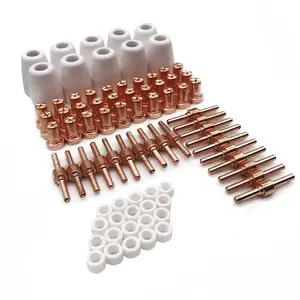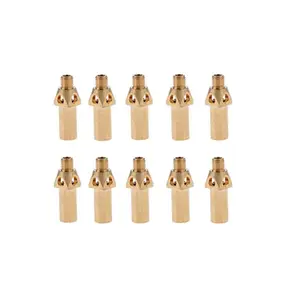(338 products available)










































































































































































































A tip jet burner is a type of power tool that can be used for various purposes, such as cutting, welding, heating, or melting materials. There are two types of torches: the air-cooled torch and the water-cooled torch. The former is more common and has a built-in copper heat sink that allows it to absorb and dissipate the heat generated by the burning of the gas. Some air-cooled torches can also be equipped with a water-cooled body to improve the torch's cooling performance further. The latter relies on a constant flow of water to keep the torch cool. Water-cooled torches can withstand higher levels of current and are ideal for heavy-duty welding work.
There are two primary types of torch heads: the straight torch and the swan neck torch. The former is more suitable for working on a flat surface, while the latter is more flexible and can be used to perform welding tasks in a narrow or complicated space. There are two types of ignition systems for welding torches: manual ignition and automatic ignition. The former is done by manually opening the gas valve and using a striker to ignite the flame. The latter is more convenient and safer, and it can automatically ignite the flame by pressing the ignition switch.
The following are some common tip jet burners:
They are tools that use the combustion heat of gas and oxygen to achieve gas welding. The main structure of the welding torch includes a gas nozzle, an oxygen nozzle, a mixing chamber, a combustion chamber, and a copper tip. The working principle is that the gas and oxygen are separately ejected from the gas nozzle and the oxygen nozzle and then mixed in the mixing chamber. After ignition, the mixed gas starts to burn in the combustion chamber, forming a high-temperature flame. The copper tip is used to change the shape of the flame and protect the nozzle.
A propane tip jet burner is powered by propane gas. The burner head has multiple holes and nozzles, which can spray a mixture of gas and air into a specific pattern of flames after ignition. The propane tip jet burner is small and portable, easy to use. It can be used for outdoor cooking, camping, and heating.
A cutting torch is an important tool in metal cutting. It mixes oxygen and acetylene to produce a high-temperature flame, which can melt the metal being cut. The main cutting torch components include a torch, a cutting tip, a mixer, and a handle. The handle is used to hold the cutting torch, and it is equipped with control valves that can adjust the flow of gas and be used for ignition. The mixer is used to mix oxygen and acetylene in the right proportion. The cutting tip is at the front end of the torch, used to control the size of the flame and prevent backfire.
Tip jet burners are made up of various components. Here are the specifications of each part.
Tip jet burners can be powered by different fuels such as propane, natural gas, butane, and LPG. Each fuel type has unique specifications.
It controls the fuel pressure and ensures the tip jet burner operates within the required pressure range. The pressure regulators have different pressure adjustment ranges.
It is used to ignite the fuel. The ignition system of a tip jet burner can be electrical or manual. The ignition system also includes a spark plug and a control unit.
It provides a stable flame output. The flame control can adjust the flame height and shape. Some tip jet burners have flame guards to prevent accidental contact with flames.
The nozzle delivers the fuel from the source to the burner, where it ignites and produces a flame. The nozzle is available in different materials and sizes.
Maintaining a tip jet burner is crucial for its performance and longevity. Here are a few maintenance tips to consider.
It is important to clean the tip jet burners regularly to remove dirt, debris, and soot buildup. This helps to prevent clogging and ensures optimal performance.
It is important to inspect the tip jet burners for any signs of leaks. Check the fuel connections, hoses, and fittings. If any leaks are detected, they should be addressed promptly.
Users should inspect the components of the tip jet burners. This includes the nozzle, flame control, ignition system, and pressure regulator. Ensure all parts are properly connected and in good condition.
It is important to ensure the operating environment of the tip jet burners is appropriate. Avoid exposure to extreme temperatures, moisture, or corrosive elements. This can protect the burners and extend their lifespan.
The versatile tip jet burner finds application in a variety of fields.
The tip jet burner can be installed as a power source in the vertical take-off and landing of helicopters. It is also useful for engine starting and anti-icing systems in aircraft. The precise control of gas flow and flame temperature provided by the tip jet burner is suitable for the high-precision welding and heat treatment processes of the metal materials used in the aerospace field.
The tip jet burner can be used as a power source for water jet propulsion systems in boats and ships. It is also suitable for ship engine starting, heating systems, and desalination equipment. The tip jet burner's corrosion resistance and durability characteristics enable it to meet the requirements of long-term use in a harsh seawater environment.
The tip jet burner can be used as a power source for gas turbine engines in vehicles to provide propulsion. It can also be used for vehicle engine starting, heating, and air conditioning systems. The tip jet burner is often used in automotive manufacturing to carry out precision cutting, welding, and painting applications.
The tip jet burner is a standard device in the energy industry for gas turbines, which can provide electricity generation. It can also be used in the oil extraction process. The tip jet burner is used to heat crude oil, separate impurities, and improve oil recovery efficiency.
The tip jet burner can be used for cutting, welding, and brazing in construction. It is also an essential heating tool for asphalt paving and welding of plastics in the construction industry. The tip jet burner can quickly heat the material and has the advantages of easy operation and portability.
The tip jet burner can be used in the process of sterilization, disinfection, and drying in the medical and pharmaceutical industries. It can also be used for precise cutting in medical equipment manufacturing and medical treatment. The tip jet burner can achieve fast heating, uniform heat distribution, and precise temperature control, which meets the high standards of the medical and pharmaceutical industries.
When choosing a tip jet burner, the following factors should be considered.
It is important to understand the specific application requirements of the tip jet burner. This includes the type of fuel needed, the required flame temperature and size, and any other specific performance parameters.
It is important to choose a tip jet burner with good quality to ensure its performance, reliability, and safety. The burner should meet relevant industry standards and regulations.
When choosing a tip jet burner, energy efficiency should be considered. Some high-efficiency burners feature advanced fuel-air mixing technology and control systems to optimize combustion and reduce energy consumption.
Depending on specific needs, consider the size and type of the tip jet burner. Select the appropriate burner size to match the required heat output, and choose the right type of burner to meet the specific application requirements.
Some tip jet burners provide advanced control and automation features, such as remote operation, precise flame adjustment, and safety interlocks. Depending on specific needs, consider the level of control and automation required.
When choosing a tip jet burner, it is necessary to balance performance and quality with costs and budget constraints. Compare different burners based on their performance, features, and prices, and choose the one that offers the best value for the specific application.
It is important to note that when selecting a tip jet burner, it is important to consult with professionals and suppliers, and evaluate the burner based on actual needs and specific application scenarios.
Q1: What is the principle of a tip jet burner?
A1: The tip jet burner is a device that mixes fuel with oxygen before burning. It works by passing oxygen through a small orifice using a high-pressure pump or by entraining it with the gas flow. The oxygen then ignites, usually using a spark or pilot flame, which then burns the fuel, creating a high-temperature flame.
Q2: What are the applications of tip jet burners?
A2: Tip jet burners are widely used in various industries. In the manufacturing industry, it is often used for cutting and welding various materials. In the field of precision machining, it is used for precise trimming and shaping of workpieces. In addition, tip jet burners are also widely used in the fields of automotive manufacturing, electronics, and jewelry processing.
Q3: What are the advantages of tip jet burners?
A3: Tip jet burners are versatile and efficient devices for heating, cutting, and welding. They can produce high-temperature flames that can reach very high temperatures in a short amount of time. Additionally, tip jet burners have the potential to achieve precise control and automation, which can improve production efficiency and product quality.
Q4: What are the limitations of tip jet burners?
A4: Although tip jet burners have many advantages, they also have some limitations. For example, the equipment requires a stable and adequate supply of fuel and oxygen, which may result in more complex infrastructure and safety requirements. In addition, the high temperature and pressure generated by the burners may cause safety hazards, so the operating environment and conditions of the equipment need to be strictly controlled.